Stress alerts on wearable devices matter because they detect your body’s physiological changes—like decreased heart rate variability and increased skin conductance—often 20 seconds before you consciously recognize stress. You’ll receive real-time notifications that trigger personalized interventions, from guided breathing exercises to mindfulness prompts, preventing anxiety escalation. This proactive approach builds self-awareness, helps identify personal stress triggers, and promotes healthier coping behaviors. The technology behind these life-changing alerts reveals fascinating insights about your autonomic nervous system responses.
Understanding Physiological Data Behind Stress Detection
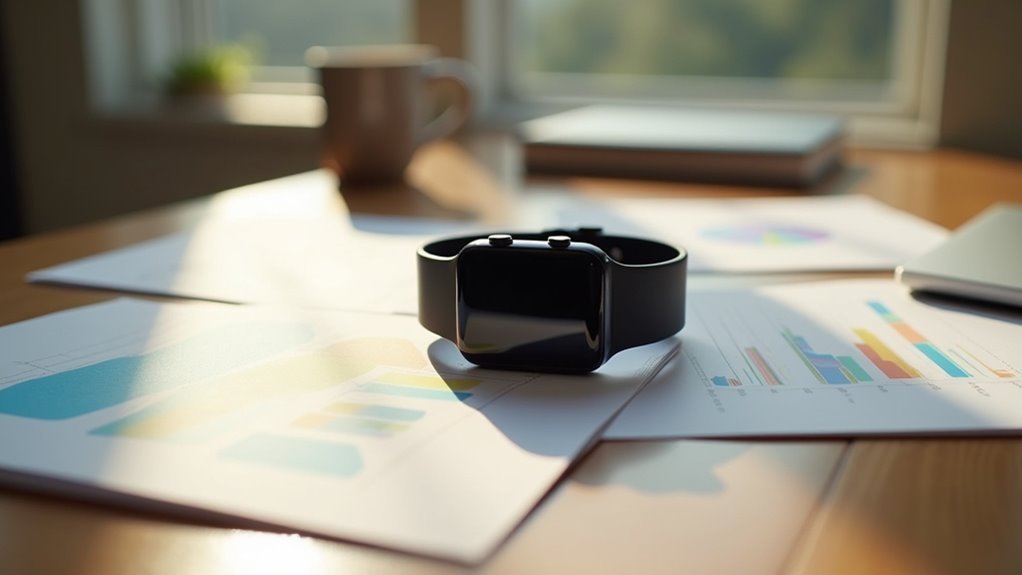
When you’re feeling stressed, your body responds with measurable physiological changes that modern wearable devices can detect and analyze in real time.
Your wearable captures key signals including heart rate, respiration rate, electrodermal activity (EDA), and skin temperature through PPG and ECG sensors. These devices process raw signals to extract specific features like pulse amplitude, frequency variations, and breathing patterns that indicate stress levels.
Modern wearables detect stress by monitoring heart rate, breathing patterns, skin temperature, and electrodermal activity through advanced PPG and ECG sensors.
Continuous monitoring reveals gradual stress onset that short-term health checks might miss. Machine learning algorithms analyze these physiological features to differentiate between stress and non-stress states, often achieving over 90% accuracy. Unlike traditional methods that rely on subjective questionnaires and interviews, this approach eliminates personal bias from stress assessment.
The technology becomes even more effective through personalization, adapting to your individual baseline patterns to provide tailored stress detection that accounts for your unique physiological responses.
How Heart Rate Variability Reveals Your Stress Levels
While your heart beats in a seemingly regular rhythm, the subtle variations between each beat tell a complex story about your stress levels.
Heart rate variability (HRV) measures these tiny time differences between heartbeats, revealing how your autonomic nervous system responds to stress.
When you’re stressed, your HRV decreases markedly. Key metrics like RMSSD and SDNN drop, while your average heart rate increases as your sympathetic nervous system takes control.
Your parasympathetic activity—responsible for relaxation—diminishes, reducing high-frequency power in HRV measurements.
Your wearable device captures these beat-to-beat intervals continuously, establishing your personal baseline.
This allows it to detect early physiological stress signals before you consciously feel overwhelmed, giving you the opportunity to engage coping strategies proactively. Higher HRV scores indicate improved vagal tone and better autonomic regulation, which correlates with enhanced emotional and physical functioning.
The Role of Electro-Dermal Activity in Real-Time Monitoring
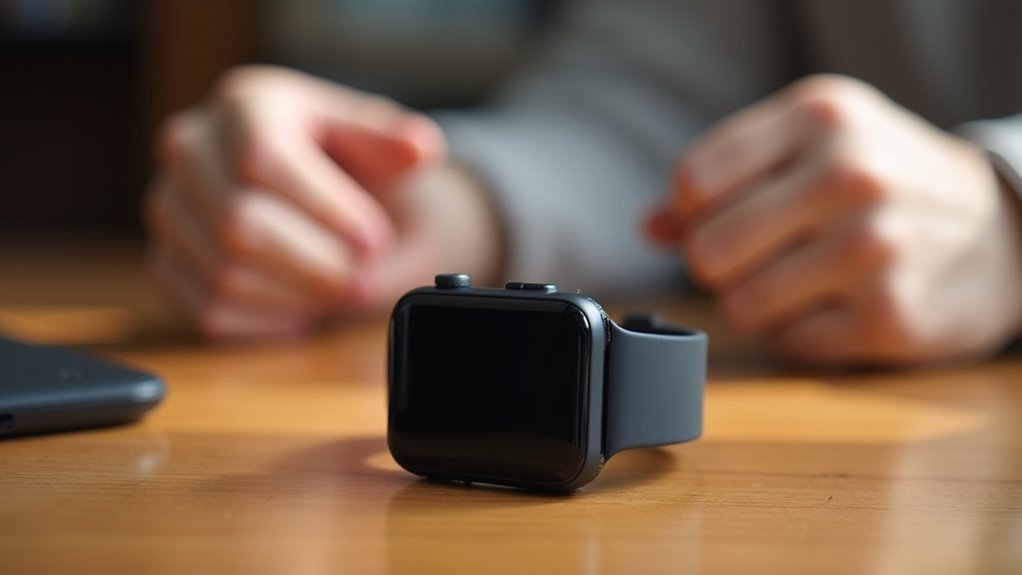
Beyond monitoring your heart’s rhythm patterns, your wearable device taps into another powerful stress indicator through electrodermal activity (EDA)—the measurement of your skin’s electrical conductance as it responds to sweat gland activity.
When you’re stressed, your sympathetic nervous system triggers increased sweat production, causing your skin’s conductance to rise. Your wrist-based device detects these changes in real-time, providing immediate feedback about your stress levels.
This technology achieves impressive accuracy, with studies showing stress detection rates averaging 82.6%. Some advanced algorithms using Support Vector Machine models reach up to 92.9% accuracy.
EDA monitoring captures both tonic and phasic components, where baseline conductivity levels reflect your general arousal state while sudden spikes indicate immediate reactions to stressors.
Your device streams this physiological data continuously, enabling instant stress alerts that help you recognize stress patterns before they escalate. This immediate awareness empowers you to implement stress-reducing strategies when you need them most.
Machine Learning Algorithms That Power Stress Recognition
When you wear a stress-monitoring device, sophisticated machine learning algorithms work behind the scenes to analyze your physiological data and identify stress patterns in real-time.
You’ll find that these systems employ various algorithm types—from Support Vector Machines and Random Forests to advanced neural networks—each designed to recognize the subtle changes in your heart rate, skin conductance, and other biometric signals that indicate stress.
The real magic happens through specialized processing frameworks that can instantly interpret streaming sensor data on your wrist, enabling your device to alert you the moment stress levels spike. These algorithms achieve remarkable 98% accuracy in stress detection by continuously analyzing multiple physiological indicators simultaneously.
Algorithm Types and Applications
As wearable devices continuously capture your physiological data, sophisticated machine learning algorithms work behind the scenes to transform raw sensor readings into meaningful stress insights.
Support Vector Machines excel at classifying your stress states, while Logistic Regression models offer simple, interpretable distinctions between stressed and relaxed conditions.
Decision Trees and Random Forest algorithms handle the nonlinear relationships in your heart rate variability and skin conductance data with high accuracy.
Neural networks detect complex patterns across multiple sensors simultaneously, and ensemble methods combine various models to boost reliability. Advanced systems like Stress-Track achieve remarkable 99.5% accuracy through sophisticated ensemble approaches that integrate Random Forest and Gradient Boosting algorithms.
These algorithms enable real-time stress alerts, personalized monitoring based on your unique physiological patterns, and continuous health tracking that can identify concerning trends before they escalate.
Real-Time Processing Frameworks
While understanding which algorithms power stress detection provides the foundation, implementing these models in real-time requires specialized processing frameworks that can handle continuous data streams from your wearable device.
These frameworks must efficiently process physiological signals like EDA and PPG as they’re collected, transforming raw data into meaningful features through sophisticated pre-processing and filtering techniques.
Your device’s framework faces the challenge of maintaining high accuracy while operating under computational constraints. Real-time processing enables immediate stress alerts, unlike offline analysis that only provides post-hoc insights.
The framework must adapt to your individual physiological responses and account for contextual factors that influence stress levels. Ensemble learning approaches help improve detection accuracy by combining multiple algorithms to create more robust predictions than single-model systems. Continuous model refinement through user feedback guarantees your wearable’s stress detection improves over time, delivering personalized and actionable insights.
Popular Wearable Platforms for Stress Alert Technology
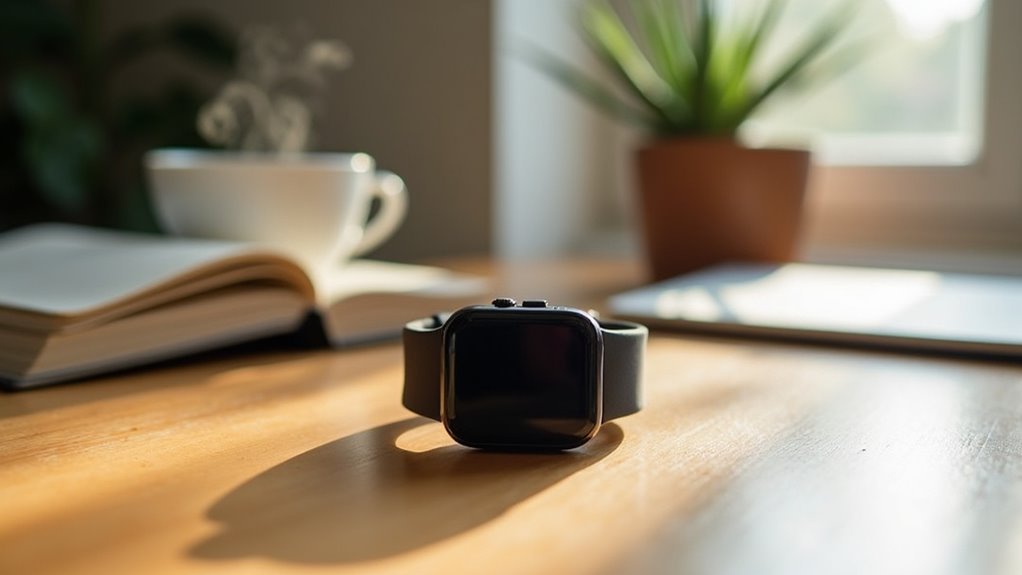
You’ll find that specialized platforms like Empatica offer extensive stress monitoring capabilities that go beyond basic fitness tracking.
Emotiv’s advanced sensor technology focuses on neurological indicators to detect stress patterns with remarkable precision.
Shimmer’s robust data collection systems provide researchers and developers with the detailed biometric information needed to create more accurate stress alert algorithms. Each brand uses different approaches since no universal metric exists for measuring stress across wearable devices.
Empatica Platform Capabilities
Innovation drives Empatica’s approach to stress detection through its medical-grade wearable devices that capture extensive physiological data.
You’ll find their EmbracePlus smartwatch and E4 wristband integrate multiple high-precision sensors, including Electrodermal Activity (EDA), PPG, accelerometer, and temperature monitoring.
Unlike other wearables, Empatica emphasizes EDA because it’s directly connected to your sympathetic nervous system responses during stress.
The platform delivers end-to-end remote monitoring with real-time data transfer via Bluetooth to mobile apps, then securely syncs to cloud storage.
You can access raw sensor data and clinically validated digital biomarkers through their dedicated research portal. The EmbracePlus features IP67 waterproofing that allows safe wear in water up to 1 meter deep for 30 minutes, ensuring continuous monitoring even during water activities.
The technology’s been validated in clinical trials monitoring thousands of participants, supporting diverse therapeutic research areas with scalable monitoring solutions that adapt to specific study protocols.
Emotiv Sensor Technology
Moving beyond traditional physiological monitoring, Emotiv takes stress detection to your brain itself through advanced EEG headset technology.
You’ll find two standout models: the Insight with 5-channel EEG and semi-dry sensors requiring no gel, and the EPOC X featuring 14 channels for more detailed neural activity capture. Both offer wireless connectivity and work seamlessly with your devices.
You can leverage machine learning algorithms like KNN and Fuzzy Logic that achieve high accuracy in classifying your stress levels from the EEG data.
The headsets’ portability makes them perfect for field research or self-quantification. You’ll get up to 20 hours of battery life with motion sensors detecting head movements, enabling thorough stress monitoring through direct brain activity analysis. The Insight model features semi-dry polymer sensors that draw moisture from the environment for enhanced conductivity without requiring traditional gel or saline solutions.
Shimmer Data Collection
Research-grade precision meets wearable convenience with Shimmer’s sensor platforms, which capture detailed biophysical and kinematic signals specifically designed for stress monitoring applications. You’ll benefit from their multi-modal approach that combines ECG, EMG, GSR, and IMU sensors to provide thorough physiological insights into your stress responses.
| Signal Type | Measurement Focus |
|---|---|
| ECG | Heart rate variability patterns |
| EDA/GSR | Skin conductance for autonomic arousal |
| EMG | Muscle tension indicators |
| IMU | Movement and posture data |
Shimmer’s continuous data collection supports both controlled laboratory conditions and real-world environments. You’ll receive raw physiological data that feeds directly into machine learning pipelines, enabling real-time stress classification with validated correlation to biochemical markers like salivary cortisol. The platform’s reliability is demonstrated through its thousands of publications across medical, neuroscientific, and clinical research markets.
Real-Time Feedback Benefits for Immediate Stress Management
When your smartwatch buzzes with a stress alert, you’re getting more than just a notification—you’re receiving a real-time intervention that can change how you manage stressful moments. These immediate alerts enable you to respond before stress escalates, enhancing your self-regulation capabilities through timely awareness.
Your wearable device transforms stress management by providing:
- Instant physiological monitoring – tracking heart rate variability and respiratory patterns
- Customized intervention recommendations – tailored strategies based on your stress levels
- Guided breathing exercises – accessible relaxation techniques during stressful periods
- Pattern recognition alerts – helping you identify personal stress triggers
This real-time feedback loop increases your engagement with stress management practices. Advanced wearables utilize ECG sensors to provide more detailed insights into your cardiovascular response during stressful situations.
You’ll find yourself more likely to use stress-reducing techniques when prompted immediately, leading to better adherence and more effective stress relief.
Accuracy Improvements Through Multi-Sensor Data Integration
While single sensors provide valuable stress indicators, combining multiple physiological signals dramatically enhances your wearable device’s accuracy in detecting stress levels.
Multi-sensor fusion leverages heart rate variability, electrodermal activity, skin temperature, and photoplethysmogram data to achieve detection accuracies above 80%. Your device can now differentiate between low, moderate, and high stress levels with improved granularity.
This integration reduces false positives by corroborating measurements across sensor modalities. When your ECG sensor combines with PPG and pulse rate variability sensors, accuracy reaches 86%.
Machine learning algorithms like random forest process this heterogeneous data, enabling continuous monitoring in real-world conditions. You’ll receive more reliable stress alerts because multi-sensor approaches outperform single-device methods, adapting to your individual physiological baselines for personalized stress detection.
Psychological Benefits of Proactive Stress Notifications
When your wearable device sends you a proactive stress notification, you’re equipped with immediate awareness that can greatly reduce anxiety levels before stress escalates.
These timely alerts encourage you to engage healthy coping behaviors like deep breathing or taking a brief walk, rather than letting stress build unchecked. Modern wearable devices can identify stress levels within approximately 20 seconds, providing rapid intervention opportunities.
You’ll find that consistent exposure to these notifications naturally promotes better self-care practices, as you become more attuned to your body’s signals and develop stronger habits for managing your mental well-being.
Reducing Anxiety Through Awareness
As stress alerts buzz against your wrist, they’re doing more than simply notifying you of elevated heart rate or increased electrodermal activity—they’re creating a powerful psychological intervention that builds self-awareness and emotional resilience.
These proactive notifications help you recognize early stress signals and connect physiological changes to emotional triggers. When you understand your stress patterns, you can respond more effectively before escalation occurs.
The awareness mechanism works through four key processes:
- Pattern Recognition – You identify recurring stress-mood relationships over time.
- Trigger Awareness – You link physiological changes to specific situations or emotions.
- Early Intervention – You catch stress episodes before they intensify.
- Self-Regulation – You develop informed responses to manage anxiety proactively.
This continuous feedback loop transforms unconscious stress responses into conscious management opportunities, fostering psychological resilience. However, it’s important to recognize that wearable devices may also contribute to anxiety and fear among some users when alerts are frequent or misunderstood.
Encouraging Healthy Coping Behaviors
Beyond simply alerting you to stress, wearable devices actively guide you toward healthier coping mechanisms by delivering timely interventions that reshape how you respond to challenging situations.
When your device detects elevated stress levels, it prompts you to take regular breaks or engage in physical activity rather than relying on unhealthy habits. You’ll become more aware of how stress impacts other wellness areas like sleep quality, steering you toward holistic improvements.
These devices seamlessly integrate mental health monitoring into your daily routine, making sustained behavioral changes feel natural and manageable. The continuous insights motivate you to adopt proactive stress management strategies, transforming your automatic responses from reactive to thoughtfully constructive approaches. This behavioral shift is particularly important given that 41% of adults globally feel overwhelmed by stress.
Promoting Self-Care Practices
Proactive stress notifications from wearable devices create powerful psychological benefits that extend far beyond immediate coping responses. When your device alerts you to rising stress levels, it triggers a conscious recognition moment that promotes sustained self-care practices. This real-time feedback enhances your sense of control over stress responses, fostering empowerment and self-efficacy in managing your mental health.
Your wearable’s stress monitoring capabilities support thorough self-care through:
- Identifying stress-sleep patterns to modify behaviors disrupting restful sleep
- Providing personalized AI-driven insights based on your unique biometric trends
- Creating positive reinforcement cycles that increase motivation for continued self-care
- Building emotional resilience through consistent stress recognition and response training
This proactive approach shifts you from reactive to preventive mental health care, encouraging long-term emotional regulation. The sophisticated algorithms that analyze your biometric data enable these devices to deliver increasingly accurate personalized feedback that adapts to your individual stress patterns and responses.
Addressing Anxiety Concerns From Frequent Health Alerts
While wearable devices promise enhanced health monitoring, they can trigger significant anxiety that undermines their intended benefits. You’re particularly vulnerable if you have atrial fibrillation—about 20% of users experience intense anxiety from irregular rhythm notifications. This anxiety creates a vicious cycle where you’ll contact doctors immediately after abnormal alerts, obsessively monitor symptoms, and develop hypervigilant behaviors that worsen your mental well-being.
| Anxiety Triggers | Behavioral Impact | Healthcare Consequences |
|---|---|---|
| Irregular rhythm alerts | Immediate doctor contact | Increased ECGs and procedures |
| False positive notifications | Excessive symptom monitoring | Higher healthcare utilization |
| Constant health data access | Activity avoidance | Unnecessary system strain |
| Uncertainty from alerts | Social withdrawal | Resource overuse |
You’ll find yourself trapped in pathologic monitoring patterns, constantly checking crucial signs and losing trust in your body’s natural resilience. Research spanning 9 months revealed significantly higher rates of outpatient visits, inpatient stays, and cardiac testing procedures among wearable users compared to non-users.
Smartphone App Integration for Enhanced Stress Interventions
Your wearable device becomes considerably more powerful when it’s connected to a smartphone app that can process and act on your stress data instantly.
The app receives real-time biometric information from your device and automatically triggers personalized interventions the moment it detects elevated stress levels.
You’ll get immediate guided breathing exercises, mindfulness prompts, or coping strategies tailored to your specific stress patterns without having to manually check your device or remember to take action. With AI-powered capabilities advancing at a 35% annual growth rate, these stress management features are becoming increasingly sophisticated in their ability to predict and prevent stress-related health issues before they escalate.
Real-Time Data Integration
As stress management technology advances, wearable devices now seamlessly connect with smartphone apps to deliver extensive, real-time stress monitoring solutions.
You’ll benefit from continuous data flow that transforms how you detect and respond to stress patterns throughout your day.
Real-time integration provides four key advantages:
- Instant Analysis – Your stress data processes immediately for quick intervention decisions
- Personalized Alerts – Custom notifications trigger based on your specific stress thresholds
- Pattern Recognition – Apps identify your unique stress triggers and timing patterns
- Immediate Response – Breathing exercises or mindfulness prompts activate when you need them most
This integration creates a thorough stress management ecosystem where your wearable continuously monitors physiological markers while your smartphone delivers actionable insights and interventions precisely when stress levels spike. Advanced devices also track hydration levels as dehydration can significantly impact your body’s stress response and overall well-being.
Automated Intervention Triggers
When stress levels spike beyond your personalized thresholds, automated intervention triggers activate immediately to deliver targeted coping strategies through your smartphone app.
These triggers integrate cognitive behavioral therapy principles, guiding you through evidence-based techniques precisely when you need them most. Your app delivers customized resources like breathing exercises, mindfulness tutorials, and cognitive reframing tools based on your specific stress patterns and intensity levels.
This real-time intervention system transforms stress episodes into learning opportunities, prompting you to practice therapeutic skills between formal sessions.
Push notifications maintain your focus on mental health goals throughout the day, while automated triggers guarantee you won’t miss critical moments for self-management. The system provides objective measures for monitoring your therapeutic skill utilization outside of traditional office visits.
The continuous feedback loop increases your engagement and motivation for behavioral change, leading to measurably lower symptom severity over time.
Medical Applications Beyond General Wellness Monitoring
While traditional fitness trackers focus on counting steps and monitoring sleep patterns, medical-grade wearable devices now deliver sophisticated stress detection capabilities that extend far beyond basic wellness metrics.
You’re witnessing wearables transform healthcare delivery across specialized fields where stress monitoring becomes essential for safety and performance.
These devices serve significant roles in high-stakes environments:
- Military Combat Operations – Soldiers wear stress-monitoring devices that track physiological signals during missions.
- Medical Professional Support – Doctors use wearables to monitor their stress levels during intensive procedures.
- Child Safety Programs – Audio and heart rate sensors detect stress patterns in vulnerable children.
- Athletic Performance Optimization – Sports professionals minimize injury risk through continuous workload monitoring.
You’re benefiting from portable ECG monitoring and machine learning algorithms that provide real-time intervention capabilities previously impossible with traditional medical equipment. These advanced systems calculate Early Warning Scores from vital signs to enable healthcare professionals to respond more efficiently to critical situations.
Privacy and Security Considerations for Health Data
Since wearable stress monitoring devices collect your most intimate physiological data—from heart rate variability to sleep patterns—you’re fundamentally carrying a detailed record of your mental and physical state wherever you go.
You’re often unaware of how extensively this sensitive information is collected, stored, and shared with third parties.
Your device’s vulnerabilities during data transmission create opportunities for cybercriminals to intercept personal health information through Bluetooth or Wi-Fi connections.
Attackers can manipulate your health data or use insecure wearables as entry points into broader healthcare networks.
Without standardized security protocols across manufacturers, you’re relying on inconsistent protection measures. The healthcare industry leads in adopting security products for wearable devices precisely because of the sensitive nature of user data.
You need transparent consent processes, minimal data retention policies, and robust encryption to safeguard your physiological information from unauthorized access and potential discrimination.
Overcoming Technical Challenges in Stress Detection
Although your wearable device appears to seamlessly monitor stress throughout the day, it’s actually grappling with complex technical hurdles that can compromise the accuracy of your alerts.
Your device faces significant challenges collecting reliable physiological signals like heart rate variability and electrodermal activity while you’re moving around in real-world conditions.
Engineers are tackling these obstacles through several key strategies:
- Multimodal sensing – combining heart rate, skin conductance, and breathing patterns for 99-100% accuracy
- Advanced algorithms – using machine learning methods like SVMs and ensemble techniques to filter noise
- Smart sensor placement – optimizing electrode positioning to minimize motion artifacts
- Adaptive calibration – adjusting for individual differences and environmental factors
These improvements help guarantee your stress alerts remain trustworthy. Research shows that stress detection systems can distinguish between binary classification scenarios as well as more complex five-level stress categorizations with remarkable precision.
Technological Advancements Shaping the Stress Monitoring Landscape
As wearable technology evolves at breakneck speed, your stress monitoring device is becoming a sophisticated health laboratory on your wrist.
Advanced biosensors now track sweat composition, measuring electrolytes and stress biomarkers that reveal your body’s real-time responses.
Your wrist now analyzes sweat like a miniature laboratory, detecting stress hormones and chemical changes as they happen.
Electrodermal activity sensors detect skin conductivity changes linked to your sympathetic nervous system, while core temperature monitoring adds essential context to stress detection.
AI algorithms differentiate between actual stress signals and normal variations, creating personalized baselines tailored specifically to you.
Machine learning continuously refines these models, improving accuracy through user feedback and clinical validation.
You’ll receive timely alerts enabling proactive stress management.
The market’s explosive 15% growth rate reflects these innovations, with leading brands investing heavily in sophisticated sensor integration and analytics that transform raw data into actionable health insights. These advances support chronic disease management by providing physicians with comprehensive data streams that enable better monitoring and treatment adjustments for stress-related conditions.
Frequently Asked Questions
How Much Do Stress-Monitoring Wearable Devices Typically Cost?
You’ll typically pay $200-$300 for consumer stress-monitoring wearables like Fitbit Sense or Garmin Venu. However, if you need medical-grade devices, you’re looking at $1,000-$3,000+ depending on features.
What Is the Average Battery Life for Wearables With Stress Detection?
You’ll get 18-48 hours from smartwatches with stress detection, while smart bands last 5-7 days. Headband devices typically run 6-24 hours, and bodywear options provide 8-24 hours per charge.
Can Stress Alerts Work Accurately During Exercise or Physical Activity?
Stress alerts can struggle during exercise because movement creates noise in physiological signals, and your heart rate naturally elevates, making it harder for algorithms to distinguish between exercise-induced and stress-related changes.
Do Stress Alerts Function Properly for People With Existing Heart Conditions?
Your heart condition can affect stress alert accuracy since irregular rhythms from atrial fibrillation or heart failure confuse the algorithms, but wearables with multiple sensors still provide valuable monitoring capabilities.
How Long Does It Take to Set up Stress Monitoring Features?
You’ll need about 10-15 minutes to set up stress monitoring. Download the companion app, enable health integrations, adjust your fit, calibrate settings, and customize alert levels for your individual stress patterns.

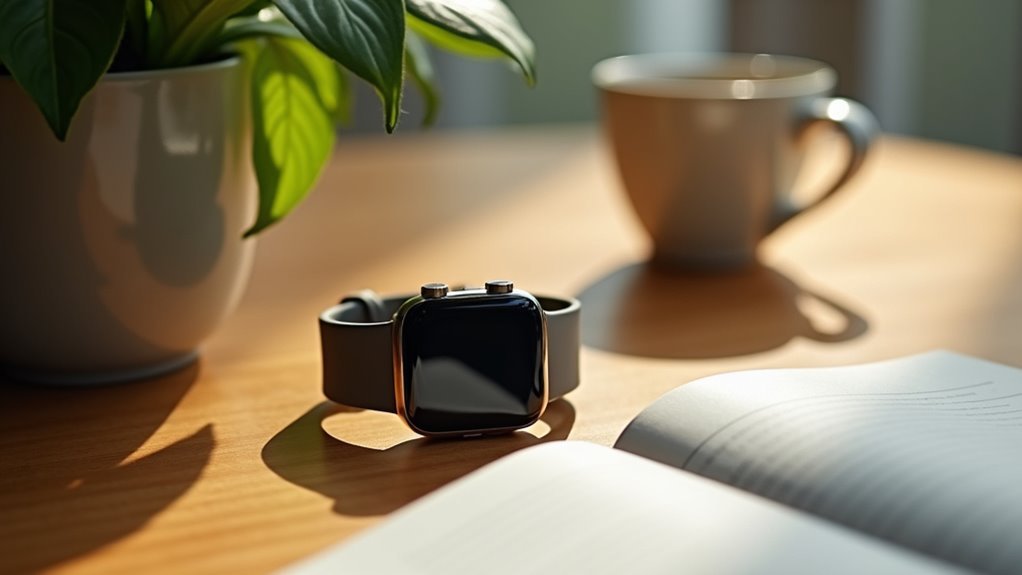
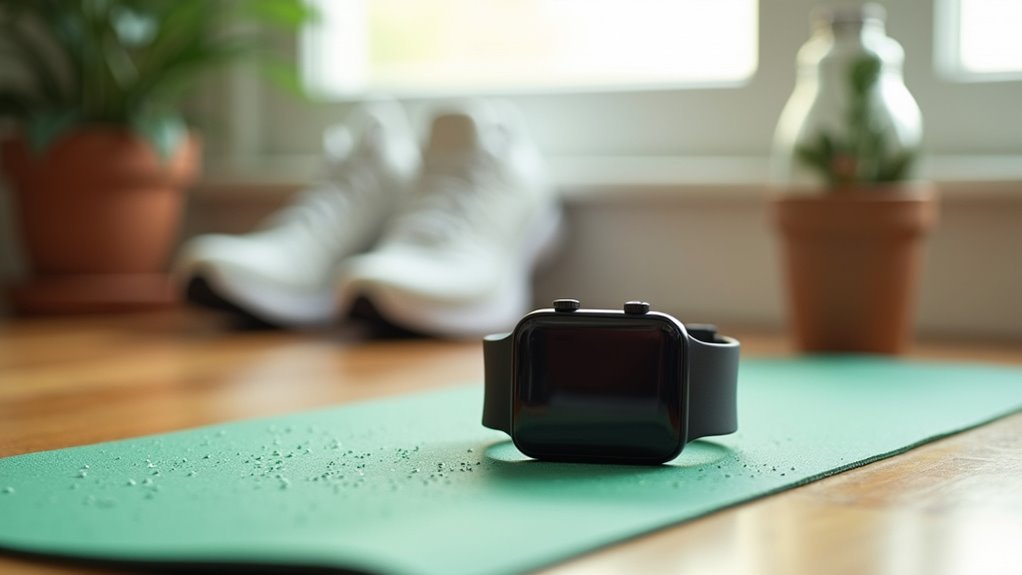
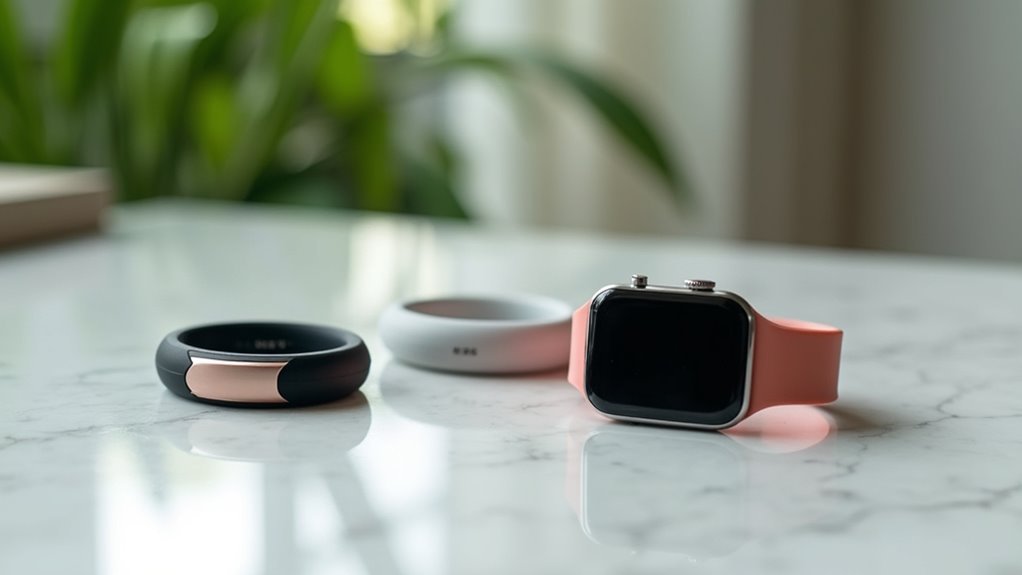
Leave a Reply